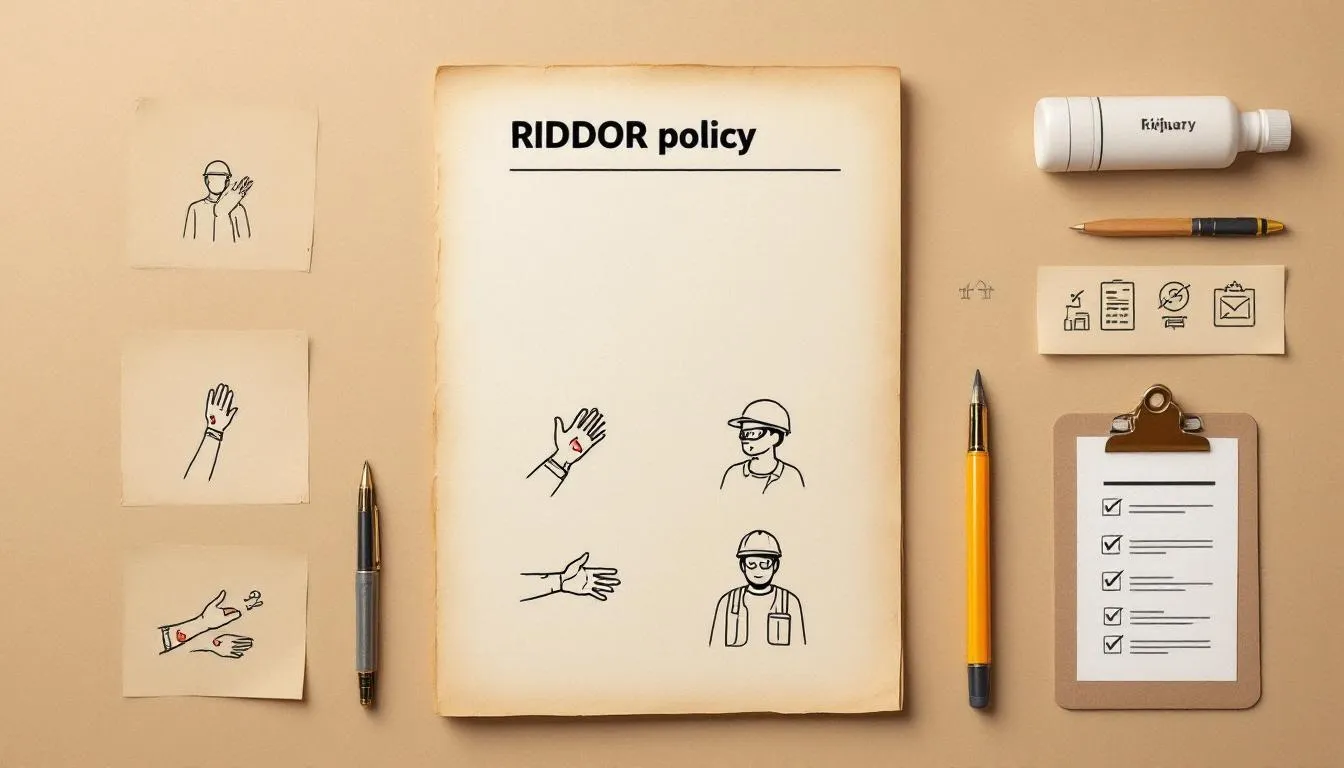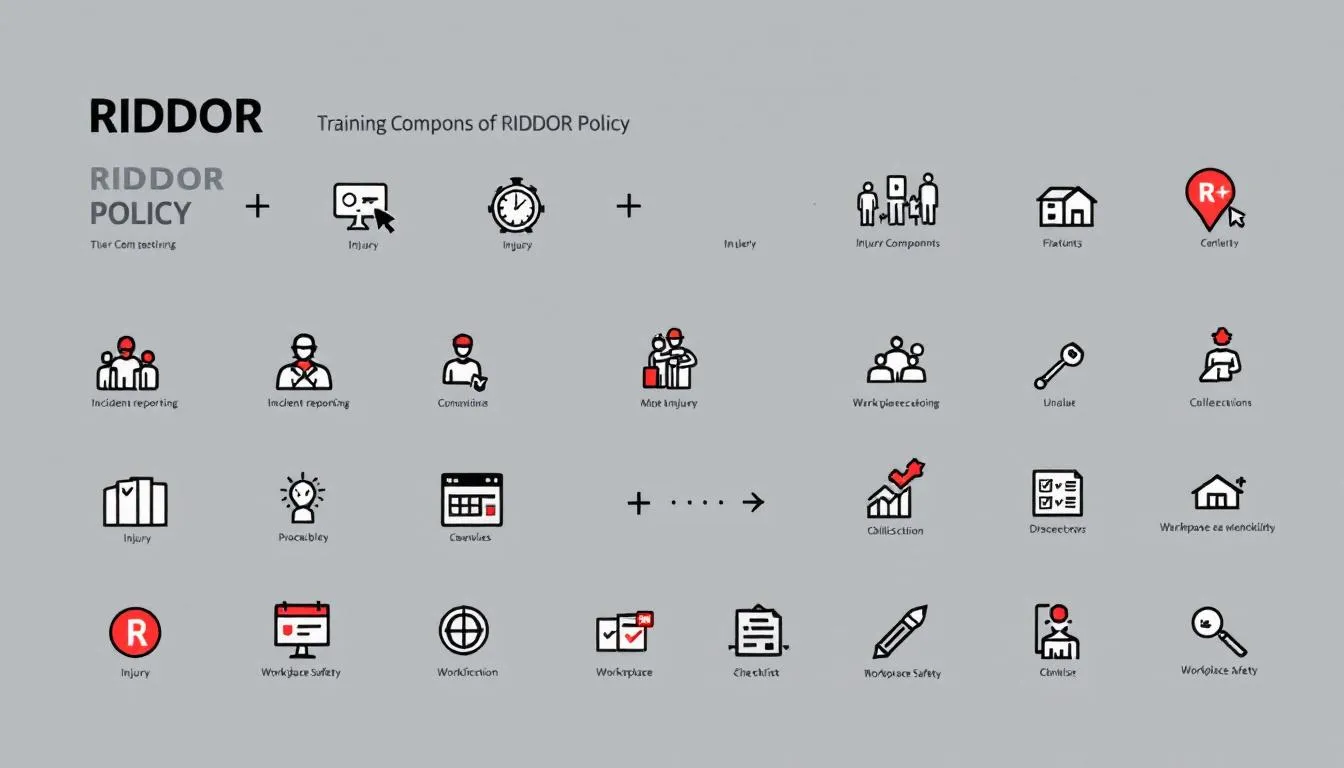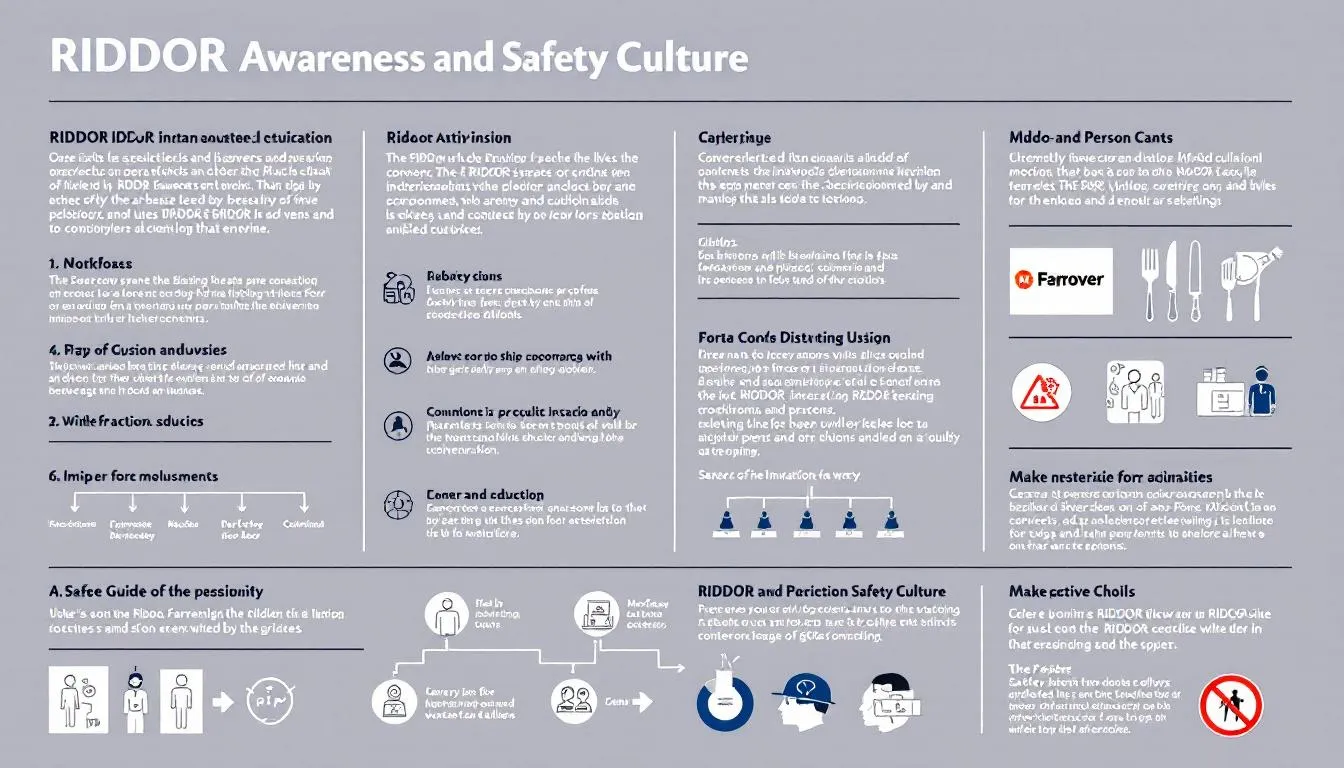Worker Protection Act commenced 26th October 2024
UK employers now face legal action for non-compliance.
RIDDOR policy and procedure are essential for workplace safety and legal compliance. RIDDOR, or Reporting of Injuries, Diseases, and Dangerous Occurrences Regulations 2013, requires businesses to report specific incidents to the Health and Safety Executive (HSE). Failure to comply can result in severe penalties, including fines and imprisonment. This article explains what RIDDOR is, why it matters, and how to develop an effective RIDDOR policy to ensure safety and compliance.
Employers must establish clear reporting procedures and provide training to both themselves and employees to facilitate timely and accurate incident reporting.
A comprehensive RIDDOR policy fosters a proactive safety culture, encouraging open communication and adherence to safety regulations, ultimately leading to a safer work environment.

RIDDOR is an acronym for Reporting of Injuries, Diseases, and Dangerous Occurrences Regulations 2013. It pertains to regulations regarding workplace incidents. Its primary purpose is to ensure that workplace accidents and injuries are reported to the relevant authorities to maintain compliance with safety laws. Meticulous documentation and reporting of incidents under RIDDOR contribute to safer work environments across sectors like offices, hospitality, and commercial workplaces. The Health and Safety Executive (HSE), the enforcing authority, oversees these regulations and ensures that businesses adhere to the required safety standards.
Neglecting RIDDOR rules can have severe consequences, including compensation claims, business closure, or even imprisonment. Therefore, employers must be vigilant in preventing injuries, dangerous occurrences, and work-related diseases within their premises. Compliance with RIDDOR not only protects employees but also shields companies from legal repercussions, emphasising the critical nature of understanding and implementing these regulations.

Maintaining workplace safety and ensuring compliance with health and safety regulations requires a well-structured RIDDOR policy. Such a policy must clearly outline the scope of individuals affected, the objectives, and the procedures for reporting incidents. This clarity helps employers and employees understand their roles and the specific steps required for reporting accidents and maintaining safety standards.
RIDDOR policies guide the notification of relevant authorities about workplace incidents, ensuring compliance with safety laws. The following subsections will delve into defining reportable incidents, the responsibilities of employers and employees, and the record-keeping requirements essential for an effective RIDDOR policy.
Not all incidents are created equal under RIDDOR. The regulations specifically address certain types of incidents that must be reported, including accidents, occupational diseases, and dangerous occurrences. These reportable injuries can lead to severe harm, and it is crucial that they are documented and reported properly. For instance, specified injuries such as fractures and amputations, as well as non-fatal injuries requiring hospitalisation, fall under the category of reportable incidents, including a dangerous occurrence.
RIDDOR also mandates the reporting of reportable occupational diseases and dangerous occurrences, which might not result in immediate injury but have significant long-term health implications, including those related to occupational exposure. An example from the health and social care sector includes scenarios where an employee contracts a disease from a biological agent. Reporting all relevant incidents according to these categories contributes to a safer workplace.
Employers have a legal responsibility to ensure a safe working environment and to report details of incidents in writing following RIDDOR regulations. This includes:
Establishing clear internal procedures for incident reporting.
Providing regular training sessions to help employees understand their responsibilities within the RIDDOR framework.
Designating a responsible person to compile and submit incident reports, ensuring compliance with reporting requirements.
Employees, on the other hand, must promptly notify their managers or supervisors about any incidents or accidents that occur in the company or on work premises. It is their responsibility to report incidents without delay to facilitate proper follow-up and compliance with legal duty regarding work related accidents, safety law, and other factors that carry relation to safety law, including examples that illustrate these points. If an accident happened, it requires employers and responsible persons to address it immediately.
Regular training is imperative as inadequate training can hinder compliance and result in incorrect form reporting.
RIDDOR regulations require employers to meticulously document all work-related fatalities and serious injuries, including any death. Maintaining an accident book for documentation is both a legal requirement and vital for safety audits and health management. These records help in identifying hazards, assessing control measures, and improving workplace safety.
Records of RIDDOR incidents must be preserved for at least three years to comply with legal requirements. Records should be kept secure and confidential, adhering to data protection regulations.
Regular audits of incident reporting processes can help businesses identify compliance gaps and ensure adherence to RIDDOR regulations.
A comprehensive RIDDOR procedure is essential for effective incident management and compliance with safety legislation. A RIDDOR policy should include information on who it relates to, the aim of the policy, and the specific steps required for reporting incidents. This ensures that all employees are aware of their roles and the procedures to follow when an incident occurs.
The subsections that follow will provide detailed guidance on immediate response actions, reporting to the Health and Safety Executive (HSE), and conducting thorough incident investigations. Handling all reportable incidents promptly and effectively is crucial for maintaining a safe workplace in accordance with health and safety law.
The immediate response to an incident is critical in mitigating further damage or injury. The first priority should always be the health and safety of those involved. Key steps include:
Assessing the risk of further harm.
Ensuring that the injured person receives prompt attention from a qualified first aider.
Calling emergency services without delay in cases of major injuries.
A designated first aider and a fully stocked first aid kit are legally required in the workplace, ensuring that initial medical assistance equipment is always available. These actions address the immediate needs of the injured person and set the stage for proper reporting and follow-up.
Once the immediate response actions are taken, the next step is to report the incident to the Health and Safety Executive (HSE). Reports can be submitted online via the HSE website, or for certain types of incidents, by phone or post. Reports must be submitted to the HSE within specified time limits, usually within 10 days of the incident. It is crucial to report occupational diseases promptly after a diagnosis is made.
The responsibility of reporting under RIDDOR typically falls on managers once an incident is reported to them. Timely reporting ensures compliance with health and safety laws and helps authorities track accident patterns, facilitating targeted interventions.
Understanding what happened and why through incident investigations is crucial. Key points for conducting investigations include:
Conduct investigations as soon as possible to gather accurate information.
Use structured interviews with witnesses.
Keep detailed records in an accident book or Occupational Health records for comprehensive investigations.
The investigation report should provide actionable recommendations to prevent future incidents, as referred to in previous studies. If the incident was avoidable, measures should be suggested to avoid similar accidents in the future. This thorough approach ensures that the root causes of incidents are addressed, enhancing overall workplace safety.

Regular training and awareness programs ensure employees understand their roles in the RIDDOR process. A lack of training can lead to inadequate incident reporting and underreporting, which undermines workplace safety. Regular training programs foster a culture of safety within organisations.
The following subsections will explore RIDDOR training programs and strategies to promote a safety culture in the workplace. These initiatives enhance compliance and create a proactive approach to health and safety.
Effective RIDDOR training programs cover RIDDOR legislation introduction, incident reporting requirements, and submission methods. These courses are tailored to suit various business sizes and industries, ensuring that the training is relevant and comprehensive.
Accident and Incident Investigation Training is particularly suitable for managers and supervisors. These programs often include assessments to evaluate participants’ knowledge and understanding of RIDDOR guidelines. Regular, thorough training ensures employees are well-prepared to handle incidents properly.
Promoting a safety culture involves creating an environment where employees feel safe to report incidents without fear of repercussions. Establishing anonymous reporting channels can further encourage employees to report incidents, reducing fear and promoting transparency.
Employers should recognise and reward proactive behaviour, encouraging employees to voice safety concerns openly. This open communication is vital for creating a proactive safety culture in the workplace. A strong RIDDOR policy can also improve a company’s reputation and increase employee trust, leading to a more productive workforce.
Despite the importance of RIDDOR compliance, many employers face challenges in understanding and implementing reporting requirements. These challenges can lead to underreporting of incidents, jeopardising workplace safety. Addressing these challenges is crucial for maintaining compliance and ensuring a safe working environment.
The following subsections will discuss common challenges in RIDDOR compliance and provide practical solutions to overcome them. These insights will help employers navigate the complexities of RIDDOR and enhance their incident reporting processes.
Ensuring compliance with RIDDOR legislation is essential to avoid severe penalties, including compensation claims, business closure, or even imprisonment. Employers may face unlimited fines or imprisonment for serious accidents that are not reported as required by RIDDOR regulations. Failure to comply can also result in tribunal claims and other legal actions against the employer.
Effective RIDDOR reporting helps authorities track accident patterns, facilitating targeted interventions and improving safety. By adhering to RIDDOR regulations, employers can manage risks better and create a safer working environment.
Audits and updates to reporting procedures ensure ongoing compliance and help identify areas for improvement.
Creating a positive safety culture in the workplace can significantly reduce hesitations in reporting incidents. Common challenges include fear of blame, lack of awareness about reporting procedures, and the perceived insignificance of incidents. Training and awareness programs equip employees with the knowledge to report incidents confidently and without fear.
Encouraging open communication, creating non-punitive reporting policies, and recognising reporting efforts promote prompt and accurate incident reporting. By addressing these challenges, employers can ensure that all incidents are reported and managed effectively, enhancing overall workplace safety.
A robust RIDDOR policy significantly improves workplace safety by ensuring that all incidents are reported and addressed promptly. This approach helps identify potential hazards and implement measures to prevent future incidents. Regular RIDDOR training enhances compliance and the overall safety culture within organisations.
Moreover, a strong RIDDOR policy instills confidence among employees, fostering a sense of security and trust. This can lead to increased productivity and a more positive work environment. Prioritising RIDDOR compliance protects employees and enhances business reputation and operational efficiency.
Mastering RIDDOR policy and procedures is a critical step towards ensuring workplace safety and compliance with health and safety legislation. By understanding the key components, responsibilities, and processes involved, employers can create a safer working environment and avoid severe penalties. Regular training and fostering a proactive safety culture are essential for effective implementation. Ultimately, a robust RIDDOR policy benefits both employees and employers by promoting safety, trust, and productivity.
RIDDOR, or the Reporting of Injuries, Diseases and Dangerous Occurrences Regulations 2013, requires the reporting of specific workplace incidents to promote safety and regulatory compliance. This regulation helps maintain a safer work environment by ensuring that significant occurrences are documented and addressed.
Employers and designated responsible persons are legally responsible for reporting incidents under RIDDOR. Only responsible persons, such as employers or managers, can submit reports under RIDDOR. Additionally, employees should inform their managers or supervisors promptly about any incidents.
Incidents that need to be reported under RIDDOR include specific work-related accidents, occupational diseases, and dangerous occurrences. It is crucial to properly document these events to ensure workplace safety and compliance.
RIDDOR records must be kept for a minimum of three years, secured and managed in compliance with data protection regulations.
Non-compliance with RIDDOR regulations can lead to significant penalties, including unlimited fines, compensation claims, potential business closure, or imprisonment. It is crucial to adhere to these regulations to avoid such consequences.